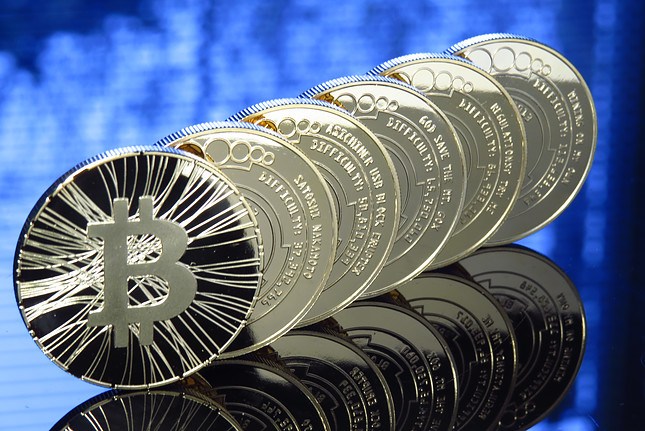Overview: Within hours of the US giving permission to Ukraine to use US weapons to strike Russian territory, which it did, Moscow announced a change it is nuclear doctrine that allow for the use of nuclear weapons against a conventionally armed adversary that is back by nuclear powers. This follows on the heels of the failure of two telecom cables yesterday (Germany-Finland and Sweden-Lithuania). This escalation is roiling the capital markets. Bonds are rallying. Equities are under pressure, and the dollar is mostly firmer. The 10-year US Treasury yield is off five basis points to 4.36%. The softer Treasury yield, after news that China and Japan unloaded a combined $112 bln US Treasuries in September (a modest $20 bln was added to Euroclear--Belgium custodian) lifted the yen to new six-session high. The Scandis are off 0.4%-0.55% and lead the decline. Emerging market currencies are mixed, but the stronger ones today are in Asia Pacific and the weaker ones are in central Europe and South Africa. Gold ended a six-day rout yesterday and rose 1.9%. It is extended the gains today by almost 1% to approach $2636.
The Nasdaq rose for the first time in five sessions yesterday, and this helped lift Asia Pacific equities today. Even India, which has been hit with foreign sales has modest gains today. However, the positive momentum has not been maintained. Europe's Stoxx 600 is off nearly 1% to post its third consecutive loss. European benchmark 10-year yields are 3-6 bp lower. US index futures are off 0.40%-0.60%. January WTI has been turned back near the 20-day moving average (~$69.25) and is trading near $68.65 in the European morning. Lastly, European natural gas has steadied today after reaching a new high for the year, which has practically doubled off from the March lows as cold weather and low winds see large draws from inventories.
Asia Pacific
The minutes from this month's Reserve Bank of Australia meeting provided little fresh insight. It remains concerned that core inflation remains too high. The futures market discount more about a 50% chance of a cut until in February, but it is not fully discounted until next May. Still, the Australian dollar is down about 1.4% this month, less than a third of a percent stronger than New Zealand dollar, which seems miniscule given that the RBNZ has cut rates by 75 bp in two moves beginning in August and is expected to deliver another 50 bp cut next week. The first thing tomorrow, Japan reports October trade figures. Recall despite the weakness of the yen, which is more than 60% under-valued according to the OCED's measure of purchasing power parity, Japan's exports contracted 1.7% year-over-year in September, the first decline since November 2023. Autos, mineral fuels, and construction machinery shipments slumped. The trade deficit, which has been consistently reported this year in all, but March and June narrowed to JPY294.1 bln in September, may have widened to nearly JPY400 bln last month.
After posting an outside down day before the weekend, the dollar traded inside its pre-weekend range against the Japanese yen. It has broken down further today and tested the 20-day moving average (~JPY153.45) and the (61.8%) retracement of the dollar's post-election rally. Yesterday's session high was set in early North American dealings near JPY155.35. The US 10-year yield did not provide strong directional cues as it was also confined to the pre-weekend range but settled softly with the lowest closing yield in five sessions (<4.42%). It is off another five basis points today (~4.36%). The Australian dollar rose for the second consecutive session yesterday. Its 0.70% gain was the largest since last week's FOMC meeting, and it traded above $0.6500 for the first time in three sessions. It reached almost $0.6525 today. It held below $0.6535, which is the (38.2%) retracement of its losses since the US election. Initial support is near $0.6480. The dollar peaked against the offshore yuan in late Asia Pacific turnover yesterday near CNH7.2530. The run at it in North America stalled slightly above CNHY7.25. The greenback slipped back below CNH7.23. It has held below CNH7.25 today and above CNH7.2250. The PBOC continues to defy market expectations with its dollar fix and this seems to be as clear of sign of it trying to moderate the dollar's ascent/yuan's descent. The dollar's reference rate was set at CNY7.1911 (CNY7.1907 yesterday). The average in Bloomberg's survey was CNY7.2326.
Europe
Yesterday, the eurozone reported that its September trade surplus of 12.5 bln euros, more than twice the median forecast in Bloomberg' survey for the seasonally unadjusted surplus (13.6 bln euros. Today, it reported a 30.5 bln current account surplus. The eurozone's current account surplus is running more than twice last year's pace (~38.5 bn euro average a month vs 18.2 bln average in the first nine months of 2023 and 32.9 bln in 2019 before the pandemic). The euro spent most of 2004-2014 above the fair-value on the OECD's purchasing power parity model, and a common explanatory narrative focused on its current account surplus. Tomorrow, the eurozone reports on negotiated wage settlements and September construction output. The UK reports October CPI tomorrow and it will likely reinforce that sense that BOE will stand pat next month. The headline CPI is expected to rise by 0.5% after the flat reading in September. Given that unchanged report in October 2023, the monthly increase will feed through to the year-over-year rate (to 2.2% from 1.7%), However, the core and services measures may slow slightly.
The euro recovered from around $1.0525 the Asia Pacific turnover yesterday and pushed above the pre-weekend high to fray $1.06. The general tone is one of consolidation and the euro is trading softer but within yesterday's range. The US two-year premium over Germany narrowed for the second consecutive session and near 210 bp was at a one-week low. It is slightly firmer today. There are options for about 855 mln euros struck at $1.0545 that expire today. Sterling also traded inside the pre-weekend range yesterday and remains within it today. It rose yesterday for the first time in seven sessions, but the failure to push above $1.2700 keeps the technical tone defensive. Sterling is holding above $1.2600. A convincing break could target $1.2450-$1.2500.
America
The US has a light economic diary this week. On tap today are October housing starts and permits. Housing starts in September were about 13% lower than at the end of last year. This may overstate the case. The average this year is a little more than 4% lower than the first nine months of 2023 and permits are off about 3.7%. Starts have been in a sawtooth pattern this year, alternating between gains and losses. However, the median forecast in Bloomberg's survey warns of the first back-to-back fall since the end of 2022. Canada reports October CPI today and the year-over-over headline is expected to rise for the first time since May. The month-over-month CPI fell by 0.6% in August/September, and the year-over-year pace fell from 2.5% in July to 1.6% in September. A 0.3% increase in October could lift the year-over-year rate to 1.9%. The underlying core rates may have held steady or ticked up. The data, coupled with the Canadian dollar at its lowest level since the pandemic, may dampen speculation about another 50 bp cut next month. The odds have slipped to about 45% from 50% a week ago.
The Canadian dollar ended a six-day slide yesterday with a 0.50% gain. After a slow start, when the greenback probed the CAD1.41 area, it trended lower through the North American morning to approach CAD1.40. The CAD1.40 area marks previous resistance and the (38.2%) retracement of the US dollar's gain since the US election. It is holding today, and the US dollar recovered to almost CAD1.4040. A break could target CAD1.3965 and possibly the CAD1.3925-30. The US dollar extended its gently decline against the Mexican peso for the fourth consecutive session, its longest streak since early October. The high carry means that it is expensive to be short the peso (and Brazilian real and Turkish lira) against the dollar or another G10 currency without strong momentum. The dollar eased to a five-day low near MXN20.2035 yesterday. It traded below MXN20.20 today but is back near MN20.25 in European morning. The MXN20.23 area is the halfway point of the US dollar rally since November 8, the day after the FOMC meeting. The next retracement (61.8%) is near MXN20.12. The greenback posted its lowest close against the Brazilian real since November 8 near BRL5.74. A move below BRL5.72 could signal a test on the BRL5.63-BRL5.65 area.
Opinions expressed are solely of the author’s, based on current market conditions, and are subject to change without notice. These opinions are not intended to predict or guarantee the future performance of any currencies or markets. This material is for informational purposes only and should not be construed as research or as investment, legal or tax advice, nor should it be considered information sufficient upon which to base an investment decision. Further, this communication should not be deemed as a recommendation to invest or not to invest in any country or to undertake any specific position or transaction in any currency. There are risks associated with foreign currency investing, including but not limited to the use of leverage, which may accelerate the velocity of potential losses. Foreign currencies are subject to rapid price fluctuations due to adverse political, social and economic developments. These risks are greater for currencies in emerging markets than for those in more developed countries. Foreign currency transactions may not be suitable for all investors, depending on their financial sophistication and investment objectives. You should seek the services of an appropriate professional in connection with such matters. The information contained herein has been obtained from sources believed to be reliable, but is not necessarily complete in its accuracy and cannot be guaranteed.
Recommended Content
Editors’ Picks

EUR/USD recovers toward 1.0600 on renewed USD weakness
EUR/USD regains its traction and rises toward 1.0600 after spending the early European session under pressure. The renewed US Dollar (USD) weakness following disappointing housing data helps the pair push higher, while markets keep a close eye on geopolitics.

GBP/USD stays near 1.2650 after BoE Governor Bailey testimony
GBP/USD trades in the red at around 1.2650 on Tuesday. Although BoE Governor Bailey said a gradual approach to removing policy restraint will help them observe risks to the inflation outlook, the sour mood doesn't allow the pair to gather recovery momentum.

Gold extends recovery toward $2,640 as geopolitical risks intensify
Gold price builds on Monday's gains and rises toward $2,640 as risk-aversion grips markets amid intensifying geopolitical tensions between Russia and Ukraine. Meanwhile, the 10-year US Treasury bond yield is down more than 1% on the day, further supporting XAU/USD.

Bitcoin Price Forecast: Will BTC reach $100K this week?
Bitcoin (BTC) edges higher and trades at around $91,600 at the time of writing on Tuesday while consolidating between $87,000 and $93,000 after reaching a new all-time high (ATH) of $93,265 last week.

How could Trump’s Treasury Secretary selection influence Bitcoin?
Bitcoin remained upbeat above $91,000 on Tuesday, with Trump’s cabinet appointments in focus and after MicroStrategy purchases being more tokens.

Best Forex Brokers with Low Spreads
VERIFIED Low spreads are crucial for reducing trading costs. Explore top Forex brokers offering competitive spreads and high leverage. Compare options for EUR/USD, GBP/USD, USD/JPY, and Gold.